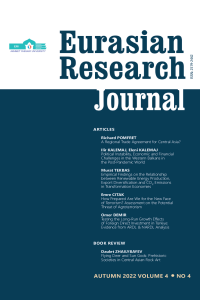HOW PREPARED ARE WE FOR THE NEW FACE OF TERRORISM? ASSESSMENT ON THE POTENTIAL THREAT OF AGROTERRORISM
Abstract
This study analyzes agroterrorism, a potential threat. Considered a sub-title of bioterrorism, agroterrorism refers to the attacks that terrorist organizations could carry out by using biological agents and pests on the agriculture and food sector. The existence of biological attacks against opposing parties at various times in history and the execution of special biological weapons programs by states reveal the possibility of terrorist organizations reaching this potential as an element of fear. The possibilities of increasing the possibilities and capacities of terrorist organizations, which constitute one dimension of the new terrorism
debate, to the extent that weapons of mass destruction could be used are discussed throughout the study. The study aims to contribute to the field by evaluating the threats that agroterrorism may pose and how prepared societies are for bioterrorist attacks.
References
- Anand, Manish (2018). “A system approach to agricultural biosecurity”. Health Security, 16(1): 1-11. Doi: 10.1089/hs.2017.0035.
- Bennett, Gaymon, Nils Gilman, Anthony Stavrianakis, Paul Rabinow and Paul Rabinow (2009). “From synthetic biology to biohacking: Are we prepared?” Nature Biotechnology, 27(12): 1109-1111. Doi: 10.1038/nbt1209-1109.
- Breeze, Roger (2004). “Agroterrorism: Betting far more than farm”. Biosecurity and Bioterrorism: Biodefence Strategy, Practice, and Science, 2(4): 251-264. Doi: 10.1089/bsp.2004.2.251.
- Carus, W. Seth (2001). “Bioterrorism and biocrimes: The illicit use of biological agents since 1900”. Center for Counterproliferation Research National Defense University. Washington.
- Chailand, Gérard and Arnaud Blin (2007). The History of Terrorism: From Antiquity to Al Qaeda, Edward Schndier, Kathryn Pulver ve Jesse Browner (trans.), California: University of California Press.
- Cooper, Melinda (2006). “Pre-empting emergency: The biological turn in the war on terror”. Theory, Culture & Society, 23(4): 113-135. Doi: 10.1177/0263276406065121.
- Crutchley, Tamara M., Joel B. Rodgers, Heustis P. Whiteside Jr, Marty Vanier and Thomas E. Terndrup (2006). “Agroterrorism: Where are we in the ongoing war on terrorism”. Journal of Food Protection, 69(12): 42-54. Doi: 10.4315/0362-028x-70.3.791.
- Cupp, O. Shawn, David E. Walker and John Hillison (2004). “Agroterrorism in the U.S.: Key security challenges for the 21st century”. Biosecurity and Bioterrorism: Biodefence Strategy, Practice, and Science, 2(2): 97-105.
- Dobson, Andrew, Kezia Barker and Sarah L. Taylor (2013). Bioscurity: The Socio-Politics of Invasive Species and Infectious Diseases. Abingdon: Routledge.
- Fong, Ignatius Wellington and Ken Alibek (2009). Bioterrorism and Infectious Agents: A New Dilemma for the 21st Century. Berlin: Springer.
- Ganor, Boaz (2009). “Trends in international terrorism”, David Weisburd et al. (Eds.), To Protect and To Serve: Policing in an Age of Terrorism. Berlin: Springer, 11-42.
- Gofas, Andreas (2012). “‘Old’ vs ‘New’ terrorism: What’s in a name?”, Uluslararası İlişkiler, 8(32): 17-32.
- Gonzales, Alberto R., Regina B. Schofield and Glenn R. Schmitt (2006). “Agroterrorism- why we’re not ready: A look at the role of law enforcement”. U.S. Department of Justice, Office of Justice Programs, National Institute of Justice.
- Gupta, Dipak K. (2005). “Exploring roots of terrorism”, Tore Bjorgo (Ed.), Root Causes of Terrorism: Myths, Reality and Ways Forward. London and New York: Routledge, 16-32.
- Keremidis, Haralampos, Bernd Appel, Andrea Menrath, Katharina Tomuzia, Magnus Normark, Roger Roffey and Rickard Knutsson (2013). “Historical perspective on agroterrorism: Lessons learned from 1945 to 2012”. Biosecurity and Bioterrorism: Biodefence Strategy, Practice, and Science, 11(1): 17-24.
- Laqueur, Walter (1999). The New Terrorism: Fanaticism and the Arms of Mass Destruction. Oxford: Oxford Univerity Press.
- Madden, Laurence V. and Mark L. Wheelis (2003). “The threat of plant pathogens as weapons against U.S. Corps”. Annual Review of Phytopathol, Vol. 41: 155-176.
- Martensson, Per-Ake, Lars Hedstrom, Bengt Sundelius, Jeffrey E. Skiby, Armin Elbers and Rickard Knutsson (2013). “Actionable knowledge and strategic decision making for bio- and agroterrorism threats: Building a collaborative early warning culture”. Biosecurity and Bioterrorism: Biodefence Strategy, Practice, and Science, 11(1): 46-54. Doi: 10.1089/bsp.2013.0039.
- Monke, Jim (2004). “Agroterrorism: Threats and preparedness”, CRS Report for Congress.
- Newman, Edward (2006). “Exploring the ‘Roots Causes’ of terrorism”. Studies in Conflict and Terrorism, 29(8): 749-772.
- Polyak, Mark G. (2004). “The threat of agroterrorism: Economics of bioterrorism”. Georgetown Journal of International Affairs, 5(2): 31-38.
- Richards, Anthony (2019). “Defining terrorism”, Andrew Silke (Ed), Routledge Handbook of Terrorism and Counterterrorism. London: Routledge, 13-22.
- Ridel, Stefan (2004). “Biological warfare and bioterrorism: A historical review”. Baylor University Medical Center Proceedings, 17(4): 400-406.
- Schmid, Alex P. (2005). “Prevention of Terrorism: Towards a Multi-pronged Approach”, Tore Bjorgo (Ed.), Root Causes of Terrorism: Myths, Reality and Ways Forward, London and New York: Routledge, 223-240.
- Schmid, Alex P. (2011). “The definition of terrorism”, Alex P. Schmid (Ed.), The Routledge Handbook of Terrorism Research. Londra and New York, 39-99.
- Smelser, Neil J. (2007). The Faces of Terrorism: Social and Psychological Dimensions. Princeton: Princeton University Press.
- Suffert, Frédéric, Émilie Latxague and Ivan Sache (2009). “Plant pathogens as agroterrorist weapons: Assessment of the threat for European agriculture and forestry”. Food Security, 1(2): 221-232.
- Tucker, David (2001). “What is new about new terrorism and how dangerous is it?” Terrorism and Political Violence, 13(3): 1-14.
- Tucker, Jonathan (2011). “Could terrorists exploit synthetic biology”. The New Atlantis, Vol. 31: 69-81.
- Tucker, Jonathan and Raymond Zilinskas (2006). “The promise and perils of synthetic biology”. The New Atlantis, No. 12: 25-45.
- Whittaker, David J. (2002). Terrorism: Understanding the Global Threat. London: Longman.
Details
| Primary Language | English |
|---|---|
| Journal Section | Research Articles |
| Authors | |
| Publication Date | October 31, 2022 |
| Published in Issue | Year 2022 Volume: 4 Issue: 4 |


